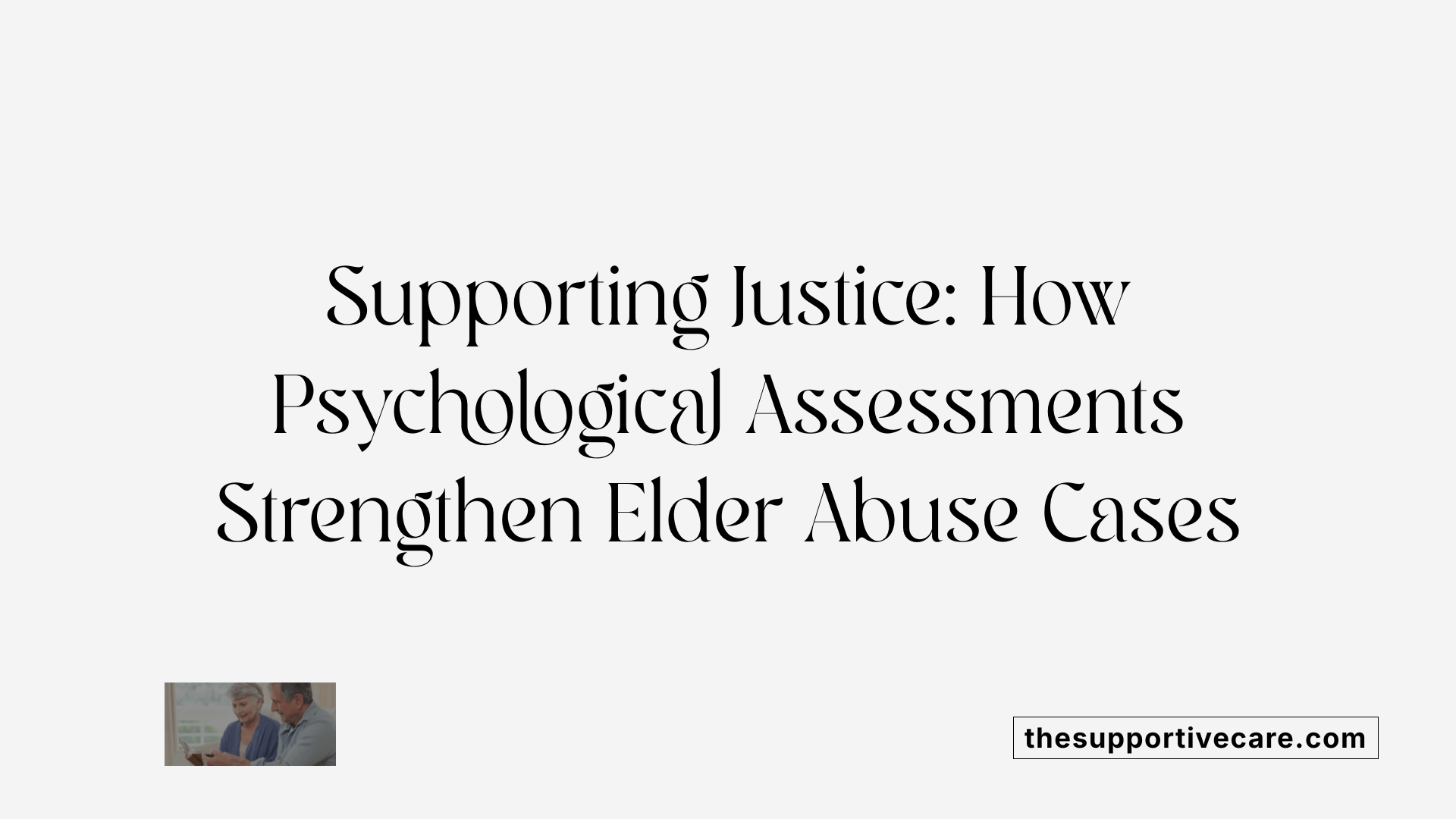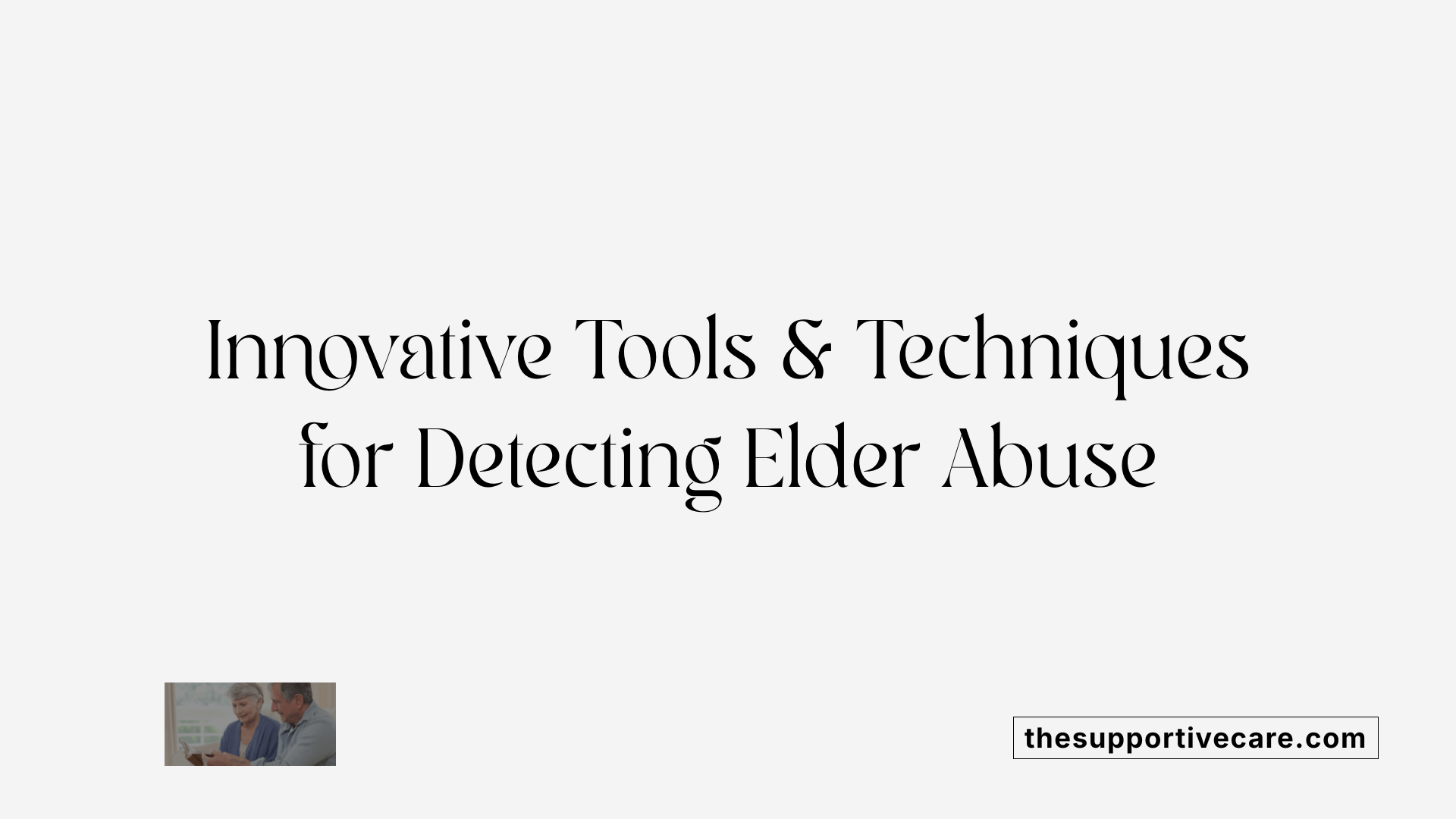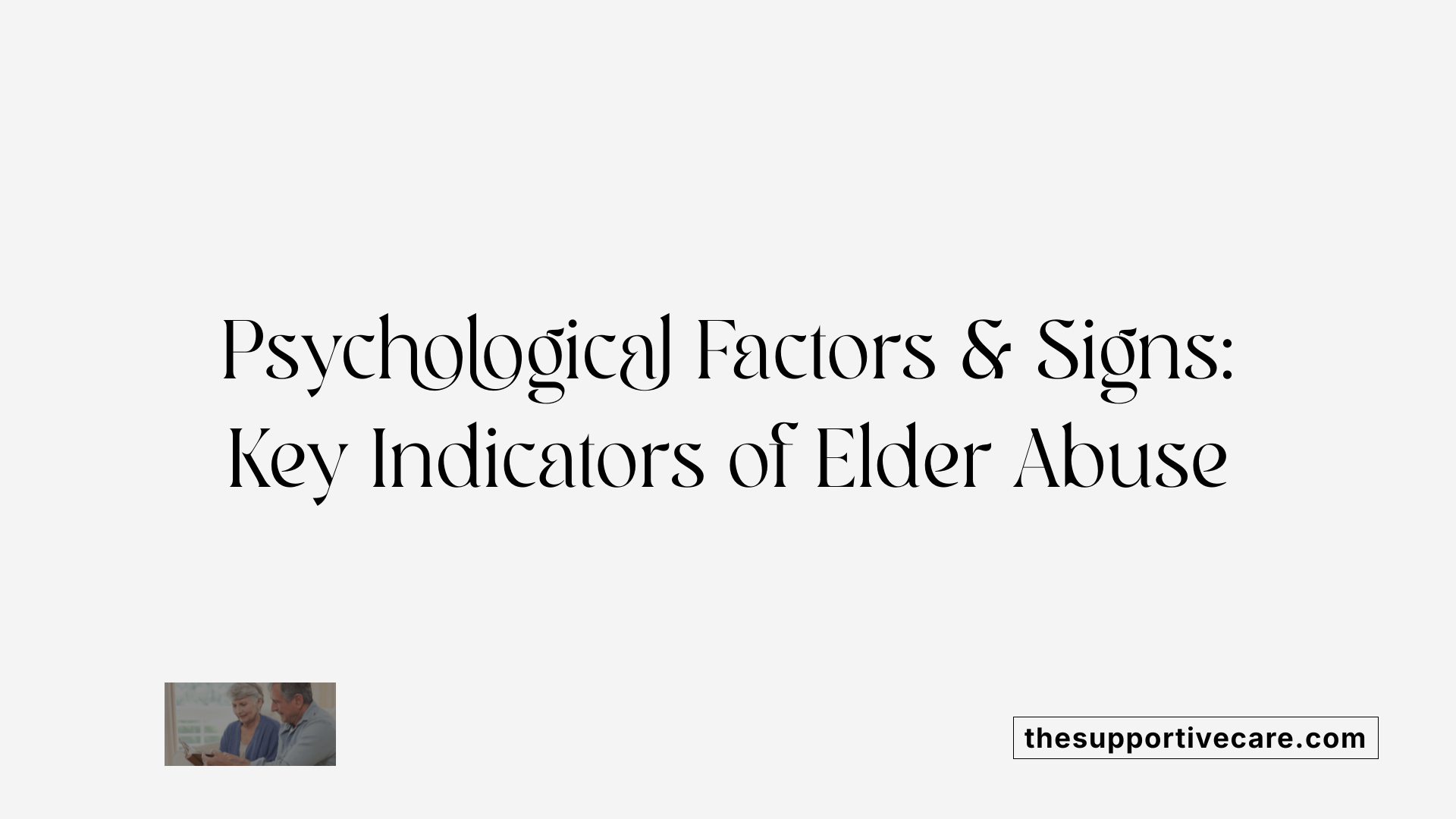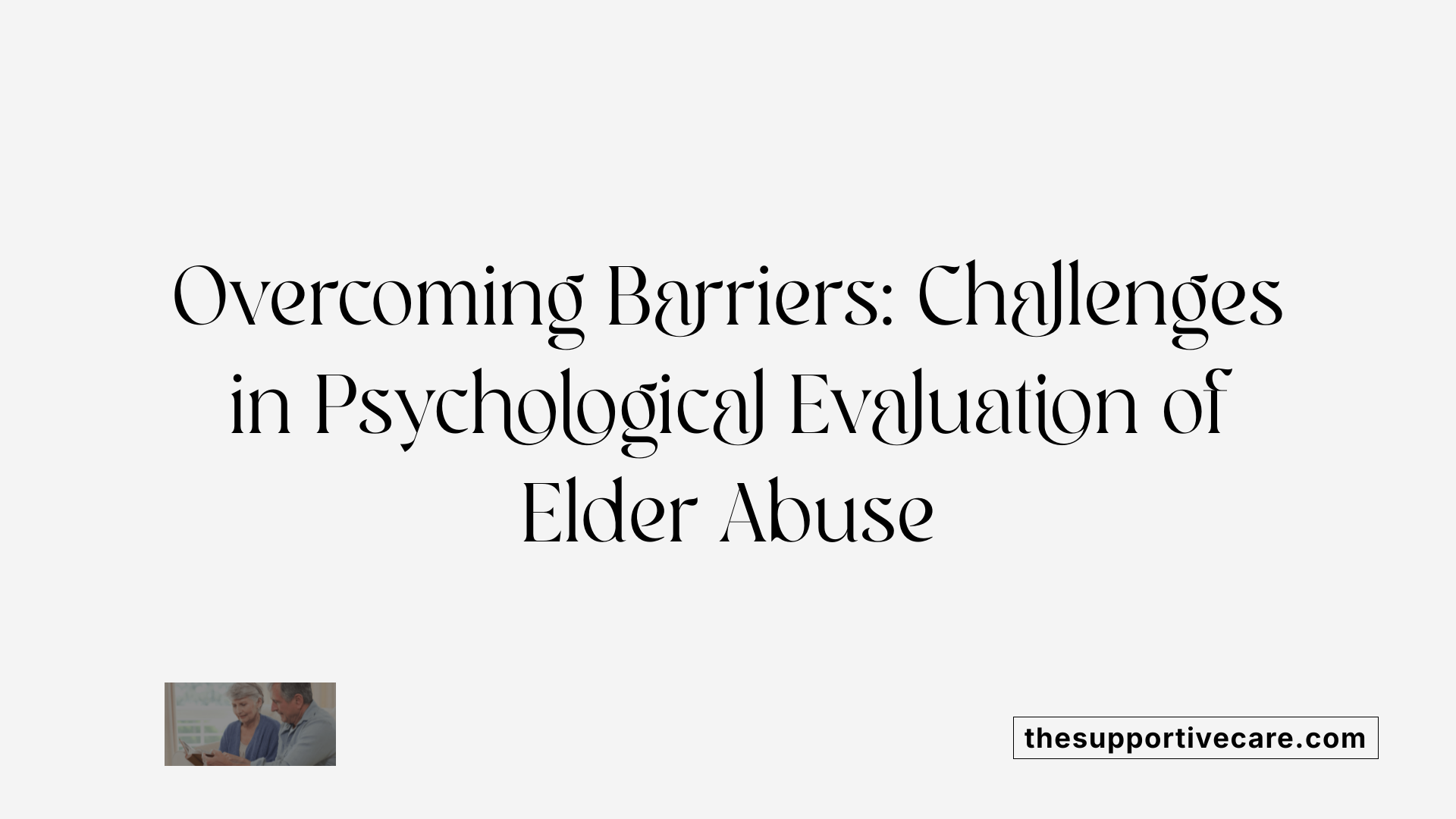Enhancing Detection and Protection through Mental Health Evaluation
Elder abuse remains a pervasive yet often underrecognized issue, with victims suffering physical, emotional, financial, and neglectful harm predominantly inflicted by trusted family members. Healthcare professionals, especially psychologists and geriatric psychiatrists, are in a pivotal position to identify and intervene in elder abuse cases. This narrative explores how psychological evaluation serves as a vital tool in assessing, detecting, and preventing elder abuse, emphasizing the importance, techniques, challenges, and legal considerations involved.
The Importance of Psychological Evaluation in Elder Abuse Cases

What evidence supports the use of psychological evaluation in elder abuse cases?
Psychological evaluation is pivotal for accurately identifying situations of elder abuse, as it helps document the mental, emotional, and cognitive health of older adults. This assessment can uncover behavioral changes, emotional distress, and psychological injuries like social withdrawal or verbal aggression—all of which may signal emotional or psychological abuse.
Validated screening tools such as the Elder Abuse Suspicion Index (EASI) are instrumental in early detection, especially when their findings are supported by physical and environmental evidence gathered during clinical examinations. Psychological assessments also assist in differentiating between signs caused by abuse and those stemming from age-related health issues, such as dementia or depression.
Furthermore, evaluations reveal risk factors like cognitive impairment or behavioral problems that can increase vulnerability to abuse. This comprehensive understanding aids in establishing patterns of maltreatment and informs targeted interventions.
Ultimately, psychological assessments serve as a vital complement to physical investigations, providing forensic evidence and supporting legal proceedings. They enable healthcare professionals to detect subtle signs of abuse, offer appropriate mental health support, and help formulate effective prevention strategies. The integration of behavioral, emotional, and cognitive data enhances the overall accuracy and effectiveness of elder abuse detection and response.
Tools and Techniques in Psychological Assessment for Elder Abuse

What techniques and tools are used in psychological assessments to identify elder abuse?
Psychological assessments in elder abuse cases employ a range of tools and methods designed to detect, evaluate, and monitor signs of mistreatment. Among the most widely used are standardized screening instruments that have been validated for effectiveness. These include the Elder Abuse Suspicion Index (EASI), the Vulnerability to Abuse Screening Scale (VASS), and the Hwalek-Sengstock Elder Abuse Screening Test (H-S/EAST).
These tools are tailored to screen for various types of abuse: physical, emotional, sexual, financial exploitation, and neglect. They often consist of questionnaires, checklists, structured interviews, and observational scales that help clinicians systematically gather information. These instruments are usually validated within particular populations, such as North American elders, and are continually being adapted to diverse cultural groups to improve their accuracy and relevance.
In addition to these standardized tools, clinicians may perform detailed interviews, observe behavioral cues, and review physical signs. They may also utilize specific cognitive assessments like the Elder Assessment Instrument (EAI), which helps identify cognitive deficits that could contribute to the risk of abuse.
Assessment strategies are designed to serve multiple prevention levels: primary (to prevent abuse), secondary (early detection), and tertiary (intervention and monitoring). Multidisciplinary teams and community validation studies play vital roles in refining these assessment techniques, ensuring they are sensitive, specific, and culturally appropriate. Moreover, future directions emphasize including elders’ perspectives and family input to enhance detection accuracy and intervention success.
Understanding the Role of Psychological Factors and Signs of Abuse

What psychological factors are associated with elder abuse and how are they assessed?
Elder abuse is often intertwined with various psychological issues that can both contribute to vulnerability and result from abusive experiences. Common psychological factors linked to elder abuse include depression, anxiety, social isolation, and cognitive impairments such as dementia or executive dysfunction. These conditions can diminish an elder's ability to advocate for themselves or recognize ongoing abuse. Assessment of these factors involves thorough geriatric psychiatric evaluations. Clinicians conduct detailed clinical interviews, mental status examinations, and utilize standardized tools like the Montreal Cognitive Assessment (MoCA) or Mini-Mental State Examination (MMSE). Screening scales such as the Vulnerability to Abuse Screening Scale (VASS) and the Elder Abuse Suspicion Index (EASI) help identify elders at risk, especially when combined with collateral information from caregivers. Special attention is given to social factors—such as social isolation or depression—and behavioral signs like withdrawal or agitation. Assessment often requires combining psychological testing with physical examinations, ensuring detailed documentation of findings. Careful interview techniques are essential, including conducting private sessions and being attentive to cultural and language differences that could affect the accuracy of evaluations. A multidisciplinary approach, integrating mental health professionals, medical examination, and legal considerations, ensures a comprehensive understanding of elder abuse’s psychological dimensions. This holistic assessment is vital to uncover underlying vulnerabilities and provide appropriate interventions tailored to the elder’s psychological needs.
What signs and indicators of elder abuse can be identified through psychological evaluation?
Psychological evaluations are instrumental in revealing subtle and overt signs of elder abuse. Victims may exhibit behavioral changes such as withdrawal from social activities, increased anxiety, depression, and agitation, or heightened fearfulness. During assessment, these signs manifest as a lack of eye contact, signs of distress, or nervousness in the presence of caregivers. Emotional or verbal signs include sounding resigned, expressing feelings of helplessness, or recounting threats or harassment. Observations of the elder's interaction with caregivers can reveal coercive or controlling behaviors, verbal threats, or emotional mistreatment. Physical indications often accompany psychological signs, such as agitation, rocking, or other self-soothing behaviors reflecting distress. In some cases, elders may show signs of trauma like bruises, scars, or signs of neglect that are consistent with psychological abuse. Psychological testing can also uncover underlying mental health issues that might be exploited or worsened by the abuse, such as untreated depression or anxiety disorders. Changes in cognitive functioning, especially executive function deficits seen in dementia, can impair an elder's capacity to report abuse effectively, making psychological evaluation a cornerstone for detection. Recognizing these signs allows healthcare professionals and other evaluators to intervene early, protect vulnerable elders, and tailor interventions that address both physical and psychological dimensions of elder abuse.
Challenges and Limitations in Psychological Evaluation for Elder Abuse

What are the challenges and limitations of using psychological evaluation in addressing elder abuse?
Psychological evaluation plays a vital role in detecting elder abuse, but it faces several challenges and limitations. One significant issue is the variability in how abuse presents, making it difficult to rely solely on psychological assessments for definitive diagnosis. Many cases lack specific diagnostic tests, so clinicians must interpret mental, emotional, and cognitive changes with caution.
Physical evidence of abuse, such as bruises or injuries, can often be subtle, absent, or mistaken for signs of age-related wear and tear. When physical signs are not evident, psychological and behavioral indicators become even more critical, though these are often subtle or non-specific. Elderly individuals with cognitive impairment, social isolation, or communication difficulties may mask or minimize their experiences, complicating assessments.
Existing screening tools, such as standardized questionnaires or interviews, have psychometric limitations. They may lack robustness, cultural sensitivity, or validated thresholds specific to elder abuse contexts, limiting their reliability. As a result, some tools may produce false positives or negatives, reducing confidence in their findings.
Ethical concerns also pose challenges in gathering sensitive information. Elderly individuals may be frail, vulnerable, or fear retaliation from perpetrators, which can hinder open communication. The risk of psychological distress during assessment must be carefully balanced with the need for thorough evaluation.
Overall, psychological evaluation should be integrated into a comprehensive, multidisciplinary approach. It is not sufficient alone to confirm elder abuse but can provide valuable insights when combined with physical examinations, social assessments, and collateral information.
What are the legal and clinical considerations involved in psychological evaluation for elder abuse?
Legal and clinical considerations are central to effective psychological assessment in suspected elder abuse cases. Clinicians must conduct evaluations with thoroughness, compassion, and respect for patient confidentiality. Gathering sufficient evidence involves detailed observation of behavioral symptoms, mood disturbances, and cognitive functioning, alongside cognitive testing tools like MoCA, MMSE, or clock drawing tests.
Understanding the elder’s decision-making capacity is critical, especially regarding financial or healthcare decisions. Clinicians should evaluate whether cognitive deficits impair the elder’s ability to make informed choices, which can have implications for legal guardianship and reporting.
Collateral information from family members, caregivers, and social networks enhances assessment reliability but must be obtained ethically and sensitively. Documentation of findings, including detailed clinical notes and standardized test scores, is essential for legal proceedings.
Legal considerations include awareness of mandatory reporting laws, which vary across jurisdictions. Clinicians have an obligation to report suspected abuse but must also consider potential impacts on the elder’s mental state and safety.
Balancing these factors requires a nuanced understanding of both medical and legal frameworks. A multidisciplinary team approach, involving social workers, legal advisors, and healthcare providers, ensures ethical integrity and supports the elder’s best interests.
This comprehensive process aims to protect vulnerable elders while respecting their rights, ensuring assessments serve both clinical and legal purposes effectively.
The Contribution of Research and Evidence in Elder Abuse Evaluation
What research findings support the use of psychological evaluation in elder abuse cases?
Research indicates that psychological assessments are vital in identifying elder abuse by documenting associated mental health conditions, behavioral changes, and emotional distress. Validated screening instruments like the Elder Abuse Suspicion Index have proven effective in detecting at-risk elders when used in conjunction with physical and environmental evaluations. These tools assist healthcare professionals in early identification, especially during private interviews where signs such as social withdrawal, depression, or increased anxiety may be evident.
Furthermore, psycho-social interventions—derived from thorough psychological assessments—have demonstrated meaningful benefits. Meta-analyses reveal an overall positive effect size of d = 0.63, especially when interventions are aimed at both elders and their families. These findings support comprehensive assessment strategies that combine clinical observations, standardized tests, and collateral information from caregivers.
Despite a limited number of randomized controlled trials focusing solely on psychological assessment procedures, existing literature underscores its importance within multidisciplinary evaluation frameworks. These approaches enable more precise, timely, and holistic responses to elder abuse, improving outcomes for victims.
How does emerging research influence practice and policy in elder abuse detection?
Recent research developments are significantly shaping practices and policies related to elder abuse. Emphasis is placed on the development and validation of culturally sensitive screening tools that can be reliably used across different populations. Incorporating psychological assessments alongside physical and environmental evaluations enhances detection accuracy, encouraging a move towards more integrated evaluation models.
Studies advocate for standardized intervention outcome measures that evaluate multiple ecological levels—individual, relational, community, and societal—to ascertain what factors contribute to successful prevention and response. The development of sophisticated tools like computerized decision support systems and tailored elder abuse risk assessment models allows for systematic screening, helping professionals identify high-risk individuals with greater confidence.
Policy frameworks are increasingly incorporating these evidence-based practices, prioritizing early detection, prevention, and ongoing management. Enhanced training programs that familiarize healthcare workers and social service providers with validated assessment protocols support this shift.
Furthermore, emerging research highlights the importance of multidisciplinary collaboration, involving healthcare, legal, social services, and community resources to address elder abuse comprehensively. This approach promotes holistic solutions, fostering safer environments for older adults and informing policy initiatives aimed at safeguarding their rights and well-being.
Conclusion and Future Directions
Why is continued importance of psychological evaluation essential in elder abuse cases?
Psychological evaluation serves as a fundamental tool in identifying and addressing elder abuse, especially in cases where emotional or psychological harm is present. It helps uncover underlying mental health issues such as depression, anxiety, or psychosis that may be both risk factors and consequences of abuse. Conducting comprehensive mental status assessments, including screening for mood and psychotic disorders, allows clinicians to better understand the elder's capacity, vulnerability, and the impact of abuse. Furthermore, psychological insights inform tailored intervention strategies aimed at both victim support and perpetrator management.
What are the existing research gaps and the need for validation?
Despite the broad recognition of elder abuse and its consequences, research on effective interventions remains limited. Large-scale randomized controlled trials are scarce, and many existing studies lack standardized measures, making comparison difficult. There is a pressing need to validate screening tools and intervention protocols across different populations and settings. Developing reliable, validated instruments tailored for diverse cultural contexts will enhance detection rates and the effectiveness of responses. Ongoing research should also focus on long-term outcomes and the mechanisms through which interventions exert their effects.
How can culturally sensitive tools and a global research effort improve elder abuse prevention?
Cultural differences influence perceptions of abuse, reporting behaviors, and help-seeking patterns. Creating culturally sensitive assessment and intervention tools is crucial to accurately identify elders at risk worldwide. Incorporating input from diverse communities helps ensure that tools are relevant and accessible, reducing barriers to detection. Expanding research beyond North America to include global populations will generate comprehensive data, emphasizing cultural nuances and social determinants. An international collaborative effort can facilitate the development of universal guidelines adaptable to local contexts, thereby improving elder protection globally.
Why is a multidimensional and dynamic understanding of elder abuse vital?
Elder abuse is a complex, evolving phenomenon influenced by individual, relational, community, and societal factors. Moving away from static, linear models, a multidimensional approach considers the interaction of risk factors such as cognitive impairment, social isolation, caregiver stress, and environmental influences. Recognizing the dynamic nature of abuse—including cycles of victimization and perpetration—allows for comprehensive risk assessments and more effective interventions. This perspective also emphasizes the importance of ongoing monitoring and adaptable support systems tailored to the changing circumstances of elders.
How can strengthening legal and clinical frameworks improve outcomes?
Robust legal policies, including mandatory reporting laws and clear guidelines for assessment, are essential to protect older adults. Clinicians and legal practitioners need standardized training on elder abuse recognition, documentation, and reporting procedures. Developing integrated, multidisciplinary protocols facilitates coordinated responses—merging healthcare, legal, social work, and mental health efforts. Ensuring that victims have access to protective services, legal recourse, and mental health care improves safety, stability, and quality of life. Continual evaluation and refinement of these frameworks based on evidence and cultural context will ensure they remain effective and responsive.
How do these future directions collectively promote safer aging?
By emphasizing psychological assessment, addressing research gaps, fostering global and culturally sensitive initiatives, understanding elder abuse as a multidimensional phenomenon, and fortifying legal and clinical structures, these strategies create a comprehensive approach. Such an approach not only enhances detection and prevention but also promotes dignity, autonomy, and well-being for older adults worldwide. Strengthening these areas ultimately contributes to a societal ethos where elder abuse is recognized, prevented, and appropriately addressed—ensuring safer and healthier aging populations.
Moving Forward: Improving Elder Abuse Outcomes
Addressing elder abuse through psychological evaluation is an essential component of a comprehensive approach to safeguarding vulnerable seniors. While significant progress has been made in understanding and developing assessment tools, challenges remain concerning the validation and cultural adaptation of evaluation methods. Future research should focus on expanding global, culturally sensitive instruments, refining outcome measures, and integrating multidisciplinary strategies to enhance detection, intervention, and prevention. Strengthening legal and clinical frameworks and promoting continuous education for healthcare professionals will be vital. Ultimately, combining psychological insight with physical and environmental evidence can foster more effective responses, ensuring older adults live with dignity, safety, and respect.
References
- Elder Abuse - StatPearls - NCBI Bookshelf
- The Effectiveness of Psychosocial Interventions for Elder Abuse in ...
- Clinical Evaluation of Elder Abuse
- Elder abuse: How to spot warning signs, get help, and report ...
- Identifying and addressing geriatric abuse - Mayo Clinic
- Archived | Addressing Elder Mistreatment | National Institute of Justice
- [PDF] What Clinical Psychology Students Need to Know About Elder Abuse
- [PDF] Understanding Elder Abuse: A Clinician's Guide
- Abuse of older people - World Health Organization (WHO)



































































































